Diocese of Pennsylvania reopens 3 churches in 5 years by rediscovering their communitiesPosted Dec 9, 2021 |
|
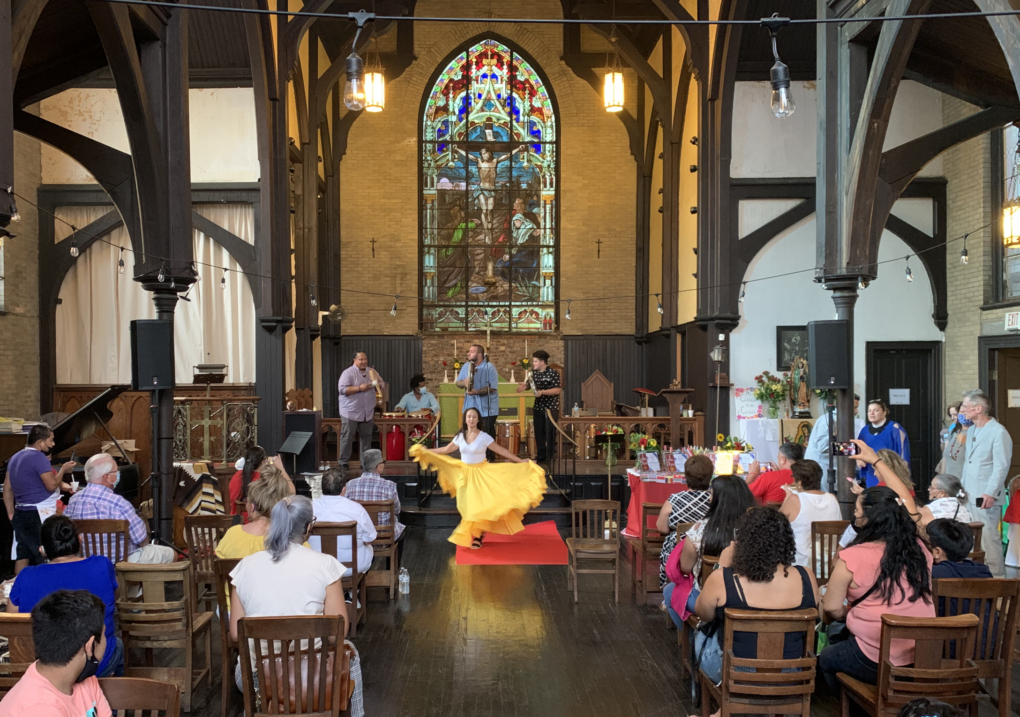
Dancers and musicians perform at the Church of the Crucifixion in Philadelphia, Pennsylvania, on Sept. 15, 2021. Photo: Egan Millard/Episcopal News Service
[Episcopal News Service – Philadelphia] By the time St. John’s Episcopal Church in the Philadelphia suburb of Norristown, Pennsylvania, closed in 2015 after 202 years, the parish had around 35 members and was about $260,000 in debt.
The cost of maintaining the ornate, neo-Gothic church – the oldest place of worship in the town of about 35,000 – was rising. The church “had a lot more funerals than we had baptisms,” senior warden Bill Kilgour told The Philadelphia Inquirer at the time. “We just didn’t have any young families and children coming up through the ranks.”
But what seemed like the end turned out to be the beginning of a new chapter in the church’s life. Since its 2017 revival, the parish has been reborn, with a new community that looks more like the town it serves. In the last 20 years, Norristown’s proportion of Hispanic/Latino residents has jumped from 10% to 27%, many of them from Puebla, Mexico. Pennsylvania Bishop Daniel Gutiérrez recognized that the shifting demographics presented an opportunity to reach new people, and he enlisted the Rev. Andy Kline, who speaks Spanish, to revive St. John’s by getting to know the neighbors and celebrating their culture. Now the church has a thriving 60-member congregation, including 20 families. It hosts a consistent stream of baptisms – at least 11 this year – fiestas and weddings, in addition to regular worship services in English and Spanish.
Some of the many baptisms that have taken place at St. John’s under the leadership of the Rev. Andy Kline. Photos: Diocese of Pennsylvania
St. John’s is one of three “resurrection churches” – along with St. Stephen’s Episcopal Church and the Church of the Crucifixion, both in Philadelphia – that the Diocese of Pennsylvania has reopened in the last five years by reorienting the churches’ ministry to respond to their communities’ shifting demographics and spiritual and material needs. Buildings that once faced the prospect of sale after their congregations folded now host lively Latino congregations, feeding ministries and outreach to homeless people. The congregations don’t look or sound like they did before, but that’s the point, diocesan leaders say.
“The three resurrection churches’ previous iterations … had become completely disconnected from their communities,” the Rev. Kirk Berlenbach, the diocese’s canon for growth and support, told Episcopal News Service. “The core of their [new] identity … is to serve the community.”
Upon becoming bishop in 2016, Gutiérrez implemented a strategy of experimentation and adaptation. A relentless optimist who views a closed church not as a permanent end but as an opportunity to repurpose, Gutiérrez told ENS: “If you look at all the successful companies, they don’t replicate what someone else has done; it’s something brand new. And I want us to think that way, like a startup.”
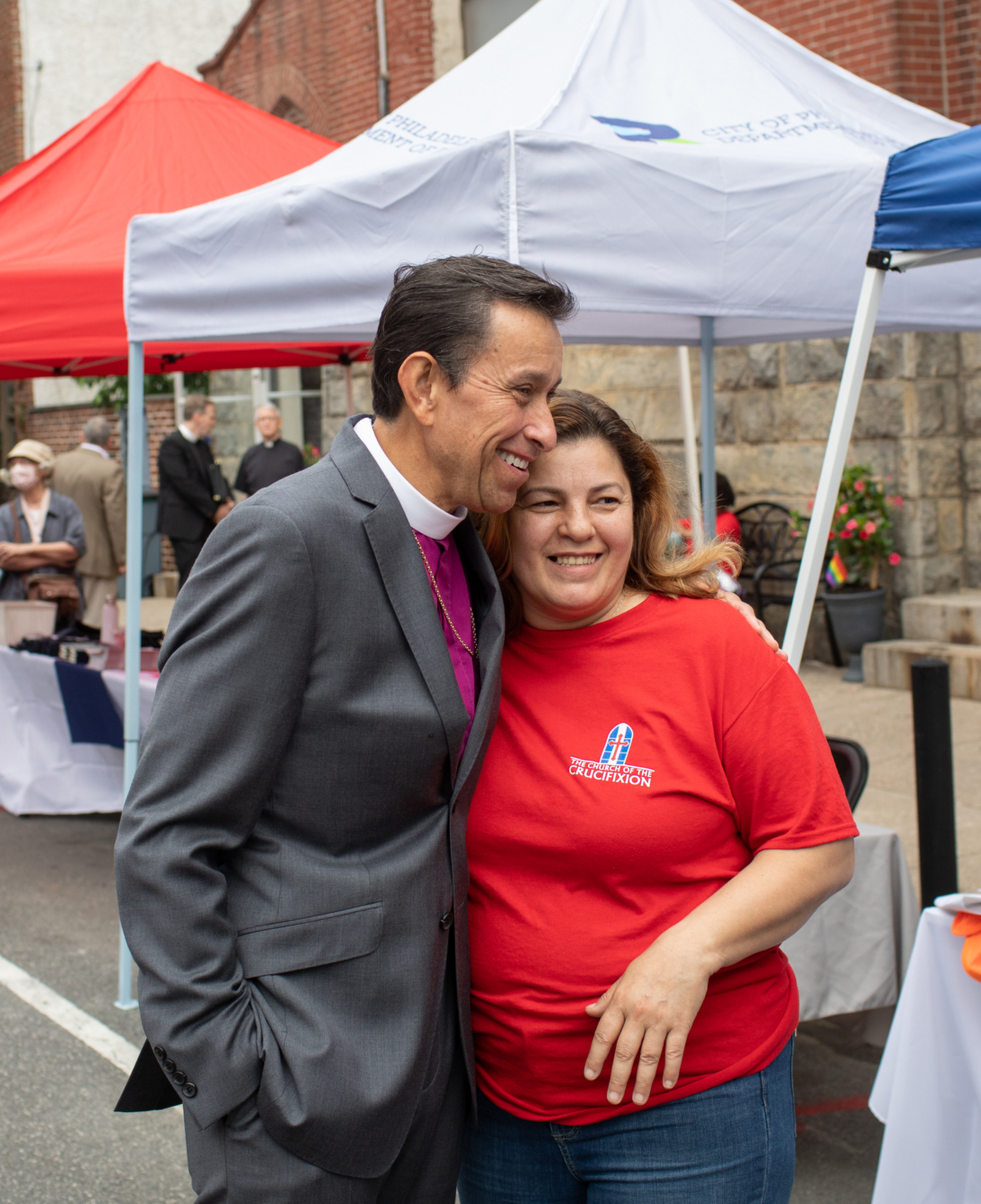
Pennsylvania Bishop Daniel Gutiérrez embraces the Rev. Yesenia Alejandro at a celebration for the reopening of the Church of the Crucifixion in Philadelphia on June 12. Photo: Diocese of Pennsylvania
Gutiérrez, whose family has roots in what is now New Mexico going back to the 16th century, previously served as canon to the ordinary in the Diocese of the Rio Grande and, before his ordination, as the mayor’s chief of staff and director of economic development in Albuquerque.
One of his first actions as bishop was to stop the potential sale of the three historic churches in Philadelphia and Norristown, all of which had stopped having regular worship services between 2013 and 2016. St. John’s was not “actively marketed” for sale because of the continuing homeless ministry there, but the other two were listed for sale.
“Selling property is just sort of survival, rather than thriving,” Gutiérrez said. “This diocese is not going to survive; we’re going to thrive.”
Diocesan staff and clergy have embraced Gutiérrez’s leadership style, describing the cultural and strategic shift that followed his consecration as “a period of renaissance” after years of normalized decline and turmoil. Gutiérrez’s predecessor, the Rt. Rev. Charles Bennison Jr., clashed with the diocese’s clergy and denominational leadership, particularly regarding his handling of assets and real estate. Bennison closed some 23 “redundant churches” during his 14-year tenure.
Since 2000, the practice of closing, merging and selling churches with low Sunday attendance has become common in The Episcopal Church and other Christian denominations. As of 2020, The Episcopal Church has 6,356 churches after hovering around 7,200 for most of the 20th century.
The Diocese of Pennsylvania was founded in 1784, though many of its congregations were originally Church of England parishes before the American Revolution, including Christ Church in Philadelphia, which was established in 1695 and a place of worship for some of the Founding Fathers.
“This is an old colonial diocese – there’s Episcopal churches within three miles of each other,” Gutiérrez told ENS. “I’d rather have one on every corner.”
Down from 193 churches in 1964, the Diocese of Pennsylvania today has 134 churches throughout Philadelphia and four of the surrounding counties. As of December 2020, it had an endowment of $79.8 million.
“We’re blessed with a significant endowment in this diocese,” said Berlenbach, canon for growth and support. “But in 20 years, [Gutiérrez] would rather see half the endowment and twice the churches than selling the churches and growing the endowment to service a smaller diocese. He would rather recast those assets to make a difference in our churches so that our churches can make a difference in our communities.”
The diocese is not using its endowment to fund the reopenings, according to canon for communications Jennifer Tucker. Each church has its own combination of funding sources.
“If we had simply decided to put millions into them, it would not guarantee success,” she told ENS.
St. John’s ministry has been funded by the parish endowment and donations as the diocese is “moving them toward self-sufficiency,” Tucker said. The diocese takes care of building expenses since moving its offices to the property, which has “resulted in substantial savings for the diocesan budget,” she said. St. Stephen’s gets funding from its own endowment and rental income, with the diocese paying the vicar’s salary. At the Church of the Crucifixion, the rector’s salary is also paid by the diocese through a budget item for Hispanic ministry, and the church is being renovated through a private nonprofit partnership supported by fundraising.
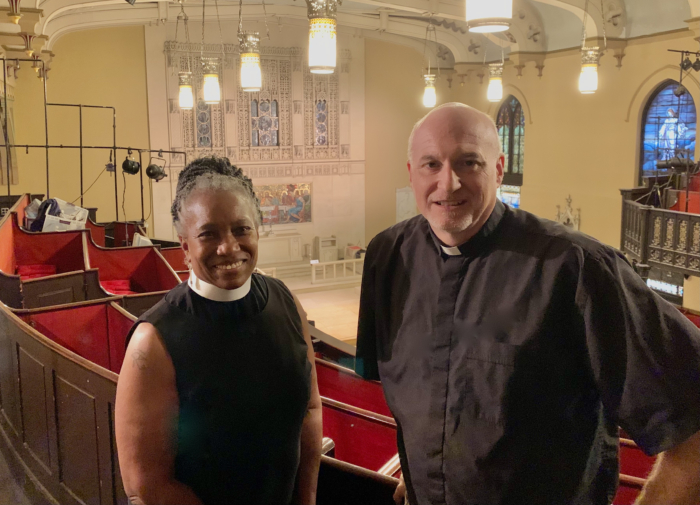
The Rev. Betsy Ivey, the Diocese of Pennsylvania’s canon for growth and support, and the Rev. Mike Giansiracusa, vicar of St. Stephen’s Episcopal Church in Philadelphia. Photo: Egan Millard/Episcopal News Service
For the diocesan leaders, reopening churches doesn’t mean trying to return them to their previous iterations. It means changing what they offer – and changing the mindset. Where others might see an albatross, Gutiérrez and his staff see unrealized possibilities.
“If you start from the negative, you have so much more difficulty getting to the positive,” the Rev. Shawn Wamsley, the diocese’s canon to the ordinary for evangelism and administration said. “Whereas if you see the opportunity that’s present here, you’re already in a much better spiritual and mental state to let the Holy Spirit move through that.”
The diocesan staff is reminded every day of the opportunities created by repurposing church properties because of where they work. In 2019, Gutiérrez moved the diocesan headquarters from a downtown Philadelphia office building to the former rectory at St. John’s in Norristown. The campus also includes a soup kitchen and homeless day shelter – which continued operating despite the parish’s closure – and the church itself, which now has a largely Latino congregation as a result of Gutiérrez’s and Kline’s efforts.
Kline has worked in parish ministry and homeless outreach in Norristown for 10 years. He built the new congregation at St. John’s largely by getting to know the neighbors, hanging out at the taquería two blocks away, and “walking the neighborhood and meeting people and seeing what they needed,” he said. “Once you made that pastoral contact, they found that you wanted to celebrate their culture.”
Many of the attendees are families who are eager to bring their children to Sunday school, Kline said, and they’ll invite him to celebrate the Eucharist at their homes for birthdays and other special occasions. The highlight of the year is the Feast of Our Lady of Guadalupe in December, which includes a procession around the neighborhood and a mariachi band.
“People had said, ‘Oh, a Mexican community will never work here,’” Gutiérrez recalled. “When we had our [first] fiesta for Our Lady of Guadalupe, it’s a freezing December evening and people were packed in there, kids bringing flowers, they were walking in a procession around the block. And the music!”
Whereas St. John’s has built a new congregation focused around Sunday worship, St. Stephen’s in downtown Philadelphia has been reborn as “kind of a test lab for what it looks like when you don’t have a Sunday morning congregation,” Wamsley said.
That’s because the area around St. Stephen’s has changed radically since the church was built in the 1820s. Its imposing castle-like building four blocks from Independence Hall once towered over a neighborhood of brick houses owned by the city’s elite professional and merchant class, as well as the original campus of the University of Pennsylvania. The parish was a high-society hub where “the congregations were large and on great occasions massed around the doors, clamoring for admission,” according to a parish history.
Today, it is wedged between a hospital, a shopping mall and a courthouse. No longer a residential neighborhood, the area is now bustling with commuting office professionals and hospital workers and patients, as well as homeless people, according to the Rev. Mike Giansiracusa, vicar.
After the congregation folded, the diocese decided to repurpose it to serve its new neighbors, reopening it in 2017. Instead of being open for an hour for Eucharist on Sunday morning, it is open during weekdays for people to come in for peace, quiet and prayer amid the noise of downtown. There are noon prayer services on weekdays, including a popular healing prayer service, as well as a new Sunday afternoon service. But a large part of its mission is just to be open to whoever walks by, rather than sustaining a regular congregation. Giansiracusa describes it as “caring for souls through sacred encounters.”
“We were never going to have a congregation, and we didn’t want one,” he told ENS. “What we wanted was a sacred encounter with whoever came in.”
The abundance of history and art at St. Stephen’s has made it a historic landmark. Photos: Egan Millard/Episcopal News Service
The well-preserved church, the oldest Gothic Revival building in Philadelphia, offers a sense of sacred oasis, with history and art everywhere you look, giving it the nickname “Philadelphia’s Westminster Abbey.” It is one of the earliest American churches to adapt church architecture from the Middle Ages, with an upper tier wrapping around the edges of the broad nave, directing one’s attention to a mosaic of the Last Supper above the altar. Tiffany stained-glass windows line the walls, and various nooks and alcoves showcase marble sculptures, including a renowned children’s memorial. Glass floor panels in one section of the church show grave slabs underneath – a churchyard that was built over in 1878.
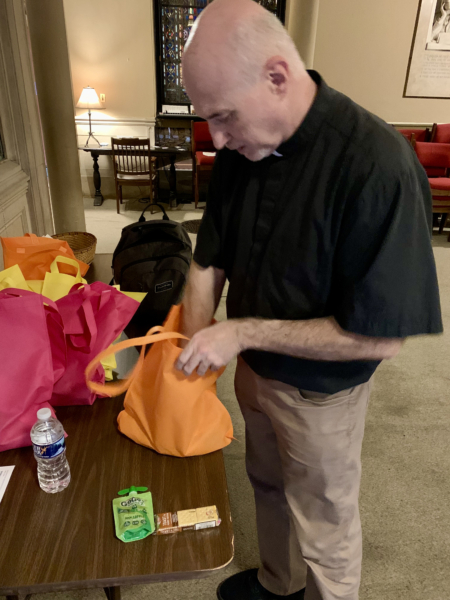
The Rev. Mike Giansiracusa fills bags of supplies to hand out to homeless people. Photo: Egan Millard/Episcopal News Service
Giansiracusa welcomes anyone who wants to come in and offers to pray with them. He has bags of essential supplies on hand for homeless people who might need them. Often, people just need to sit and reflect.
“Their doors are open to provide solace for caregivers and people visiting the hospital. A lot of those people have just come down an elevator in a hospital having seen a loved one, perhaps for the last time, so how do you help that transition?” Wamsley said.
Before the pandemic, the church hosted regular musical performances, and it is still used as a rehearsal space for a youth orchestra and other rental purposes. The diocese plans to use the space as a diaconal training center and a base from which new deacons can extend their various ministries in the city.
“My hope is that we are able to be a resource and a place of openness for anyone struggling to live out their vocation. And I think we’re positioned in the right spot to do that.”
If St. Stephen’s offers peace and quiet, the Church of the Crucifixion about 10 blocks away offers a colorful, joyous atmosphere. On Sept. 15, the church was packed with people celebrating Hispanic Heritage Month. The side aisles were crowded with food and craft vendors, and at the front of the church, musicians played traditional Puerto Rican and Mexican songs while women danced along.
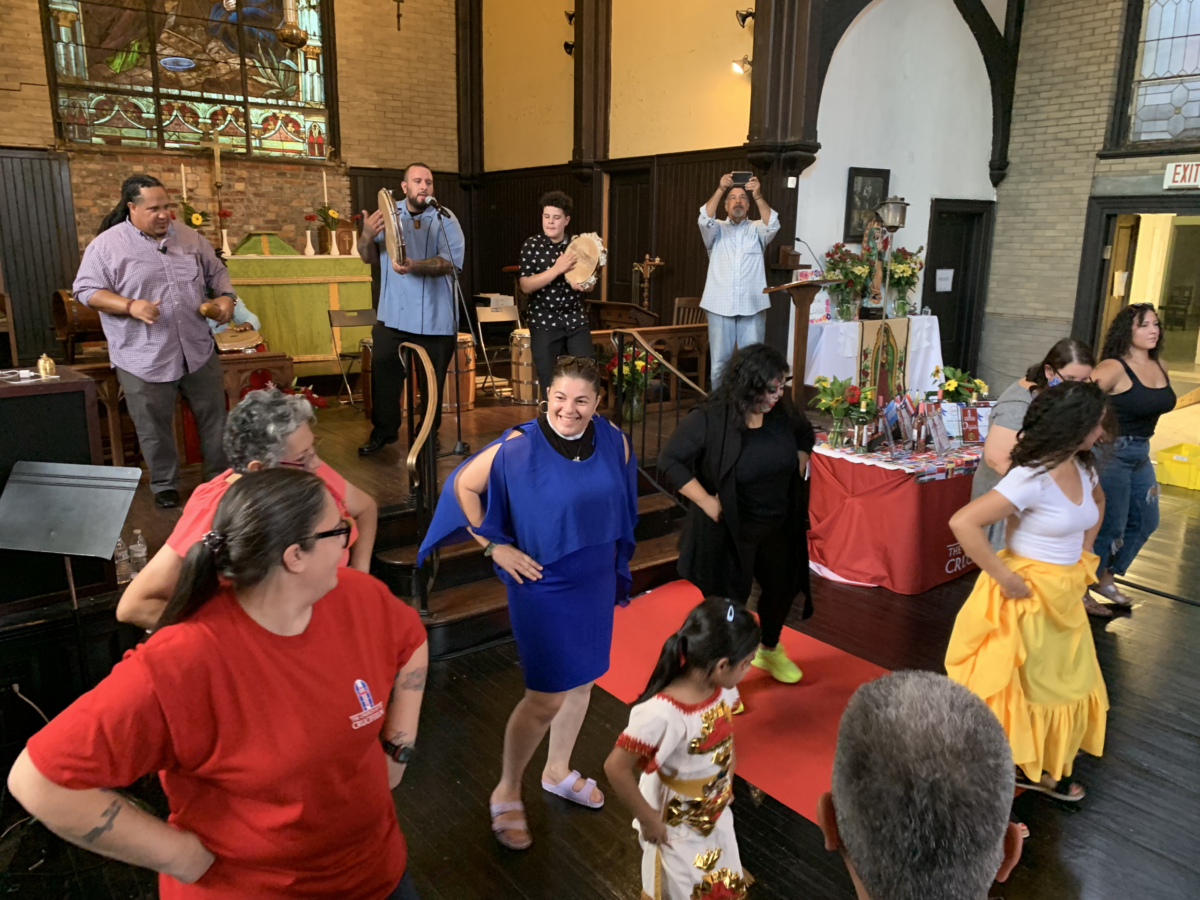
The Rev. Yesenia Alejandro (in blue) dances with others at the Church of the Crucifixion on Sept. 15. Photo: Egan Millard/Episcopal News Service
Among them was the Rev. Yesenia Alejandro, who was charged by Gutiérrez with reviving the church, which closed in 2013 and reopened in the summer of 2021. Alejandro was ordained the diocese’s first Latina priest in October 2020, through a local formation program that Sandra Montes, dean of chapel at Union Theological Seminary, designed for her.
In a few months, the church has become a hub of activity. Groups use the space for Latin and Irish dance lessons. Flea markets help local artisans sell their goods. In recent months, there have been sewing lessons, musical performances, open mic nights, historical lectures and vaccine clinics, among other offerings.
Hispanic Heritage Month is celebrated with dance, music, food and crafts on Sept. 15 at the Church of the Crucifixion. Photos: Egan Millard/Episcopal News Service
The atmosphere in the church now harks back to the parish’s heyday. Founded in 1847 as the second Black church in the diocese, the church once counted Marian Anderson and W.E.B. Du Bois among its members, with the latter calling it “the most effective church organization in the city for benevolent and rescue work.”
“When I came in, I felt that there was a spirit here,” Alejandro told ENS. “I knew that there was something here; I just couldn’t pinpoint it. But then we started to do all the ministries, whether it was the food ministry we started with. … We started to do so many other things that it started to just light up.”
The parish’s food ministry serves about 600 people each week; those who receive attend a brief prayer service first.
“Before they get the groceries, we always pray together, and we have Italians, we have Chinese, we have folks from different places, and everybody does the Lord’s Prayer in their language,” she said. “When we started, we wanted to continue to serve the Latino community, but the reality is that we’re serving all walks of life.”
Four Sunday services – two in Spanish, one in English and one bilingual – are held throughout the day to accommodate shift workers. Services that celebrate children and teach them how to serve as acolytes have been a big draw, Alejandro said, as well as traditional Mexican celebrations like the Feast of Our Lady of Guadalupe and the Day of the Dead, which the parish celebrated in late October. Colorful altars with photos of deceased relatives and friends, candles and flowers brightened the church in an event that was a first for the parish but will hopefully become an annual celebration, Alejandro said.
The diocese has developed a program to help other congregations that feel stuck to reinvent themselves, using some of the lessons from the resurrection churches, called “Casting Nets: Start-Up Plan for Churches.” The program, which is in four parts and can take as little as 10 weeks to accomplish, asks parish leaders to “dream what your church might be if it was not expending so much energy focused on buildings, people and money.”
Diocesan leaders hope that the pandemic has helped churches see that they are more capable of making real, innovative change than they thought. Churches that were not tech-savvy were suddenly doing livestream services and Zoom Bible studies, thanks to help from the diocese.
“The fact that we’re on church time, change seems to take so long,” Wamsley said, “but we got into the pandemic and … our churches made the transition in our diocese on a dime, and we’re talking a matter of days or weeks.”
But to undertake a bigger transformation, some churches may have to let go of their ideas of what a successful church looks like.
“So many of our churches are stuck trying to operate according to models that ceased being viable decades ago, and they’re getting frustrated. … They’re still trying to do all the things they were doing 50 years ago because otherwise they’re not a ‘real church,’” Berlenbach said.
“We’re trying to say, ‘No, being a real church is all about, what are we doing to know Jesus and what are we doing to make the transforming love of Jesus known in the community? Reground yourself in that.’ And that frees them from the burden of the past.”
– Egan Millard is an assistant editor and reporter for Episcopal News Service. He can be reached at emillard@episcopalchurch.org.

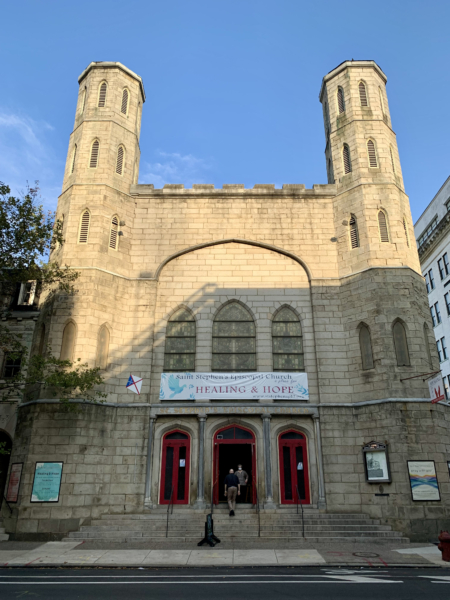
Social Menu